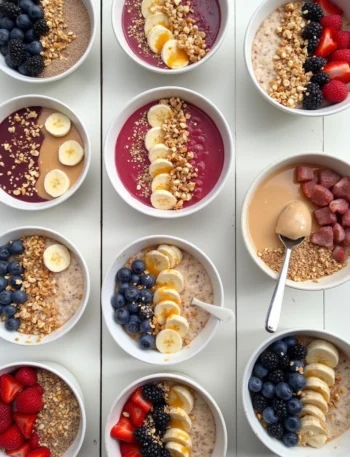In our fast-paced world, maintaining a balanced diet often falls to the bottom of our priority list. Between work deadlines, family obligations, and social commitments, it’s easy to resort to takeout or processed convenience foods. This is where meal planning comes in—a simple yet powerful strategy that can transform your relationship with food and support a healthier lifestyle.
Meal planning is the practice of deciding what you’ll eat for each meal ahead of time, typically for a week. It’s not about rigid diets or complex recipes, but rather about making intentional food choices that align with your health goals and lifestyle needs. By taking a few hours each week to plan, you can save countless hours of daily decision-making while improving your nutrition and reducing stress.
Table of Contents
Why Meal Planning Matters
The benefits of meal planning extend far beyond just knowing what’s for dinner:
- Time Efficiency: Reduce daily decisions about food and minimize multiple grocery trips
- Budget Control: Lower food expenses by reducing impulse purchases and food waste
- Nutritional Balance: Ensure your diet includes all necessary nutrients
- Portion Management: Help maintain appropriate portion sizes for your goals
- Stress Reduction: Eliminate the daily “what’s for dinner?” dilemma
- Environmental Impact: Reduce food waste through intentional purchasing
Research shows that people who plan their meals tend to have more diverse diets and better nutritional intake. According to a study published in the International Journal of Behavioral Nutrition and Physical Activity, meal planning is associated with better diet quality and lower obesity rates.
Now, let’s dive into how you can create a meal planning system that works for your unique lifestyle.
Step-by-Step Guide to Meal Planning
1. Set Your Goals

Before you start planning meals, clarify what you want to achieve:
- Weight Management: If you’re looking to lose, gain, or maintain weight, your meal plan should reflect appropriate caloric intake
- Health Conditions: Conditions like diabetes, heart disease, or food allergies require specific nutritional considerations
- Energy Levels: If you’re active or frequently tired, your meal plan should support your energy needs
- Time Constraints: Be realistic about how much time you can devote to cooking each day
- Budget Limitations: Work within your financial means while maximizing nutrition
Your goals will guide your food choices and help you create a sustainable plan. Be specific but realistic—small, consistent changes lead to lasting habits.
2. Choose a Balanced Diet
Understanding basic nutrition principles will help you create balanced meals:
Macronutrients
- Proteins (10-35% of daily calories): Essential for muscle maintenance and repair. Sources include meat, fish, eggs, dairy, legumes, and plant-based alternatives.
- Carbohydrates (45-65% of daily calories): Your body’s primary energy source. Focus on complex carbs like whole grains, fruits, and vegetables rather than simple sugars.
- Fats (20-35% of daily calories): Necessary for hormone production and nutrient absorption. Prioritize healthy fats from avocados, nuts, seeds, and olive oil.
Micronutrients
- Vitamins: Organic compounds needed in small amounts for various bodily functions
- Minerals: Inorganic elements essential for metabolism, growth, and cellular function
- Phytonutrients: Plant compounds with antioxidant and anti-inflammatory properties
A simple rule of thumb is to ensure half your plate consists of fruits and vegetables, a quarter is protein, and a quarter is whole grains or starchy vegetables. This balance helps ensure you’re getting a wide range of nutrients.
3. Plan Your Meals in Advance
Now it’s time to create your actual meal plan:
- Choose a Planning Method: Digital apps, printable templates, or a simple notebook—use what works for you
- Select a Timeframe: Most people plan for a week, but you might start with just 2-3 days
- Consider Your Schedule: Note busy days when you’ll need quick meals or days when you might eat out
- Account for Leftovers: Plan to repurpose extras to reduce cooking time and food waste
- Create Themed Days: Consider implementing “Meatless Monday” or “Taco Tuesday” to simplify planning
- Start with Dinners: If planning all meals feels overwhelming, begin with just planning dinners
When selecting recipes, look for ones that share ingredients to minimize waste. For example, if you buy fresh herbs for one dish, choose other recipes that use those same herbs.
4. Make a Grocery List
A well-organized grocery list is crucial for efficient shopping:
- Categorize Items: Group by store section (produce, dairy, grains, etc.) to save time
- Check Inventory: Before shopping, check what you already have
- Stick to the List: Avoid impulse purchases by committing to buy only what’s on your list
- Shop Seasonally: In-season produce is typically more affordable and nutritious
- Consider Frozen Options: Frozen fruits and vegetables are nutritionally comparable to fresh and reduce waste
A digital grocery list that you can update throughout the week as you notice needed items can be particularly helpful.
5. Meal Prep Strategies
Meal preparation is where your plan comes to life:
- Batch Cooking: Prepare large quantities of staples like grains, proteins, or full meals
- Component Prepping: Instead of full meals, prepare individual components that can be mixed and matched
- Strategic Chopping: Wash and chop vegetables for the week to speed up meal assembly
- Storage Solutions: Invest in quality containers that keep food fresh and are appropriate for reheating
- Prep Day: Designate a specific day (often Sunday) for meal preparation
Even 1-2 hours of preparation can save significant time during busy weekdays. Start small—perhaps just prepping breakfasts or lunches—and expand as you become more comfortable with the process.
Tips for Successful Meal Planning
Batch Cooking and Freezing
Maximize your efficiency by cooking once and eating multiple times:
- Cook double portions and freeze half for future meals
- Label frozen meals with contents and date
- Organize your freezer by meal type for easy access
- Thaw frozen meals safely in the refrigerator overnight
Some meals that freeze particularly well include soups, stews, casseroles, and cooked grains.
Healthy Ingredient Swaps
Small substitutions can significantly improve the nutritional profile of your meals:
- Plain Greek yogurt instead of sour cream
- Cauliflower rice in place of white rice
- Ground turkey instead of ground beef
- Spiralized vegetables instead of pasta
- Avocado or nut butter instead of mayonnaise
These swaps allow you to enjoy favorite dishes while boosting nutrition and often reducing calories.

Portion Size Awareness
Even healthy foods can contribute to weight gain if consumed in large quantities:
- Use measuring cups initially to understand appropriate portions
- Learn visual cues (a serving of meat is about the size of your palm)
- Pre-portion snacks to avoid mindless eating
- Consider using smaller plates to manage portions visually
Remember that portion needs vary based on age, gender, activity level, and specific health goals.
Flexibility and Adaptability
A sustainable meal plan must be flexible:
- Have a few simple backup meals for unexpectedly busy days
- Allow for occasional dining out or takeout
- Keep shelf-stable emergency meals on hand
- Swap meals within your plan based on changing cravings or schedules
- Consider keeping a “meal idea bank” for inspiration
The goal isn’t perfection but consistency—a flexible approach prevents the “all-or-nothing” mindset that often leads to abandoning healthy habits.
Common Meal Planning Mistakes to Avoid
Overcomplicating Your Plan
Many people become overwhelmed by trying to do too much too soon:
- Starting with complex recipes requiring unfamiliar techniques
- Planning different meals for every day without accounting for leftovers
- Setting unrealistic expectations for daily cooking time
- Choosing recipes with too many ingredients or special items
Solution: Start simple with familiar recipes using common ingredients, then gradually expand your repertoire.
Lack of Variety
Eating the same meals repeatedly leads to boredom and potential nutritional gaps:
- Relying on the same proteins or vegetables
- Using the same cooking methods for all meals
- Failing to incorporate different cuisines or flavor profiles
- Ignoring seasonal variations in produce
Solution: Aim for “planned variety”—different meals that still use overlapping ingredients to minimize waste.
Forgetting Snacks and Beverages
A complete meal plan includes all food and drink consumption:
- Not accounting for between-meal hunger
- Overlooking liquid calories from sweetened beverages
- Failing to plan for desserts or treats
- Not preparing for social situations or food-centered events
Solution: Plan nutritious snacks and consider your beverage choices as part of your overall nutrition strategy.
Getting Started: A Simple Weekly Framework
If you’re new to meal planning, here’s a straightforward approach to begin:
- Weekend: Take 30 minutes to select 4-5 dinner recipes for the week
- Make a grocery list: Note all needed ingredients after checking your pantry
- Sunday shopping and prep: Purchase groceries and spend 1-2 hours preparing components
- Weekday implementation: Assemble meals using your prepped ingredients
- Mid-week assessment: Evaluate what’s working and what needs adjustment
- Weekend reflection: Note successful meals and ideas for next week
Remember that meal planning is a skill that improves with practice. Each week, you’ll gain insights into what works for your lifestyle and preferences.
Conclusion
Meal planning isn’t about perfection—it’s about creating a sustainable system that supports your health goals while reducing daily stress. By taking a proactive approach to your nutrition, you’re investing in both your current well-being and long-term health.
Start with small, manageable changes. Perhaps begin by planning just three dinners per week, then gradually expand as you become more comfortable with the process. Be patient with yourself as you develop this new habit, and celebrate the small victories along the way.
Remember that the best meal plan is one you can actually follow. It should reflect your nutritional needs, time constraints, culinary skills, and personal preferences. With consistent practice, meal planning will become second nature—a valuable tool in your journey toward a more balanced lifestyle.
What small step will you take this week to improve your meal planning routine?






